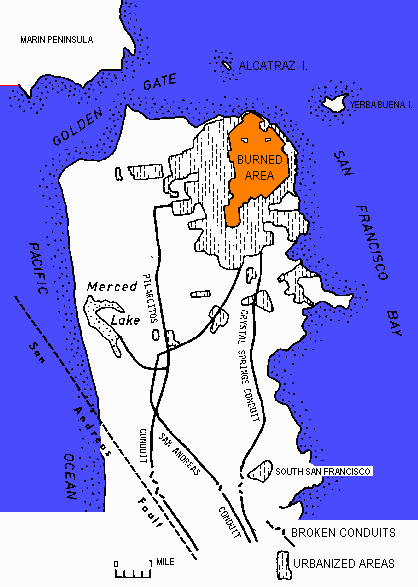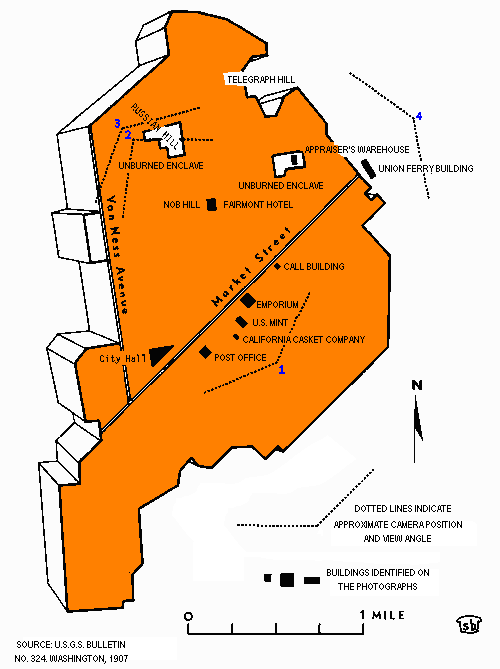
The Lawrence Captive Airship Over San Francisco in 1906 and 1908
By Simon Baker

His methods have been described by me in the Fall 1994 edition of KiteLines in an article entitled, "George Lawrence: A Giant in Kite Aerial Photography". Photographs and diagrams in that article show the Captive Airship and a panoramic camera of the type he used in San Francisco. In brief, the Captive Airship was a kite train of up to 17 Conyne kites on a piano wire cable suspending a camera held by the specially designed stabilizing mechanism. The spring operated shutter was released from the ground by a current from a battery activating a solenoid in the camera.
All photographs made with this assemblage of kites, camera, and stabilizing device were identified with the words Captive Airship. The 1960 exhibition of Lawrence's ground and aerial photographs at the Chicago Historical Society contained a view from the ground of the kites, camera, and stabilizing mechanism. The caption read as follows, "'Captive Airship' was the designation Mr. Lawrence gave this harness of tandem kites, with its ingeniously suspended and triggered camera." The Chicago Tribune of August 5, 1960 reported that George Lee Lawrence, the son of the photographer, assisted the Chicago Historical Society by providing authoritative information about the various photographs used in the exhibit. There is no doubt, then, about what Lawrence meant by Captive Airship.
 In my research conducted in the Prints and Photographs Collection of the Library
of Congress I came across five views of San Francisco taken in May 1906. "San
Francisco in Ruins" was one of four aerial Images taken by Lawrence of the devastated
area of the city. A fifth aerial image was made by him of an unburned neighborhood.
Working with detailed maps published in the U.S. Geological Survey Bulletin No. 324
published in 1907, I was able to identify the camera location for each aerial exposure.
Two books published soon after the disaster proved to be very useful in identifying streets,
neighborhoods, and individual buildings: A History of the Earthquake and Fire in San
Francisco by Frank W. Aitken and Edward Hilton published in that city by the Edward
Hilton Co. in 1906, and The California Earthquake of 1906 by David Starr Jordan also
published in San Francisco by A.M. Robertson in 1907. The maps in the U.S.G.S.
Bulletin No. 324 and the ground views in the two histories provided the basis for
constructing the map in this article.
In my research conducted in the Prints and Photographs Collection of the Library
of Congress I came across five views of San Francisco taken in May 1906. "San
Francisco in Ruins" was one of four aerial Images taken by Lawrence of the devastated
area of the city. A fifth aerial image was made by him of an unburned neighborhood.
Working with detailed maps published in the U.S. Geological Survey Bulletin No. 324
published in 1907, I was able to identify the camera location for each aerial exposure.
Two books published soon after the disaster proved to be very useful in identifying streets,
neighborhoods, and individual buildings: A History of the Earthquake and Fire in San
Francisco by Frank W. Aitken and Edward Hilton published in that city by the Edward
Hilton Co. in 1906, and The California Earthquake of 1906 by David Starr Jordan also
published in San Francisco by A.M. Robertson in 1907. The maps in the U.S.G.S.
Bulletin No. 324 and the ground views in the two histories provided the basis for
constructing the map in this article.
All four of the aerial photographs, whose locations are indicated on the map, appear in this article. Other than the spectacular "San Francisco in Ruins" (Position No. 4), the remaining three have seldom been published. They are included for their dramatic impact and to demonstrate something further about the Captive Airship. The photographs taken from Positions 1, 3, and 4 encompass an average view of 130 degrees in width. The stabilizing mechanism of the Captive Airship had three equally spaced (120 degrees apart) 15-foot-long (4.6m) booms radiating from the camera mount. One or both of these booms should be seen in each image if it was indeed made from the Captive Airship. With the camera lens set at infinity we would expect the closely located booms to appear out of focus. I have placed red pointers on the margins of each photograph where the booms are visible or have been removed by retouching. Once again I turn to the list of captions for Lawrence photographs displayed in 1960 by the Chicago Historical Society. On one of the panoramic views the following caption appeared, "The tips of the bamboo outrigging, always included in the arc of the rotating lens of the panoramic camera, were not removed (retouched) in the view of the Steamer Hamburg in this exhibit." Frequently the blurred booms were left in place out on the ends of the photographs if they were not particularly obtrusive, otherwise they were removed by retouching.
 The view from over the Bay was so spectacular that extra trouble seems to have
been taken to retouch the negative and remove the boom. However, evidence of
retouching can be seen when we know where to look (see red pointer). The question
arises about the absence of any visible boom or indication of retouching in the view from
over Hyde and Green Streets (Position No. 2). This photograph is about 10 inches (25.4
cm) shorter than the other three and appears to have been severely trimmed, thereby
removing the ends of the original negative where the booms normally showed up. One
final comment about the appearance of the photographs. On most of them we see vertical
white lines which are the cloth backing onto which the cut up large photographs were
pasted so that they could be folded for storage. The contact prints averaged four feet (1.2
meters) in length and presented handling problems in ordinary storage drawers.
The view from over the Bay was so spectacular that extra trouble seems to have
been taken to retouch the negative and remove the boom. However, evidence of
retouching can be seen when we know where to look (see red pointer). The question
arises about the absence of any visible boom or indication of retouching in the view from
over Hyde and Green Streets (Position No. 2). This photograph is about 10 inches (25.4
cm) shorter than the other three and appears to have been severely trimmed, thereby
removing the ends of the original negative where the booms normally showed up. One
final comment about the appearance of the photographs. On most of them we see vertical
white lines which are the cloth backing onto which the cut up large photographs were
pasted so that they could be folded for storage. The contact prints averaged four feet (1.2
meters) in length and presented handling problems in ordinary storage drawers.
In 1908 Lawrence returned to San Francisco to record the progress made in rebuilding the city. I am aware of at least two views made from the Captive Airship. One was taken from the land looking out toward the Bay. A second one, reproduced here, was taken from over the Bay in an attempt to duplicate the point of view of the famous "San Francisco in Ruins" of 1906. Red pointers at the top indicate the presence of two booms in this more than 120 degree view. This is different from the location of the booms at the bottoms of the 1906 photographs. The reason for this is that he now suspended the camera under the cradle beneath the booms rather than above the booms as in 1906 and before. There is no carefully lettered title in white, only a hand written identification in the lower right hand corner. This may be an indication that the photograph was not intended for sale to the public, but might have been made for private clients.
There can be no doubt about the meaning of the words Captive Airship, appearing
on the San Francisco photographs. All of the 1906 and 1908 aerial views so labeled were
made with a camera suspended by kites. There is no evidence that the stabilizing
mechanism was ever used with balloons.